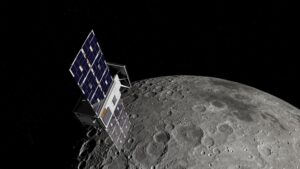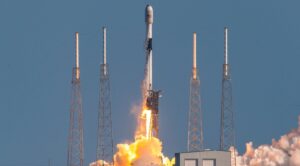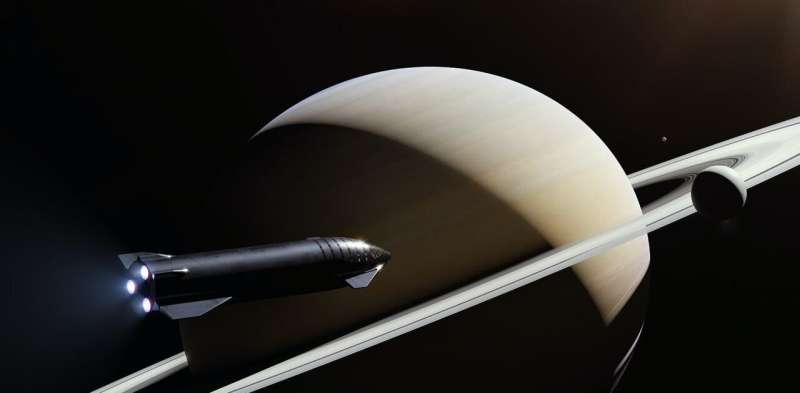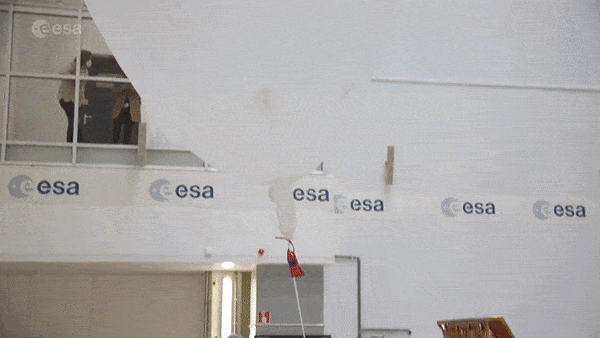CAPSTONE lunar cubesat mission to launch this spring
Tuesday, 22 February 2022 11:29
A cubesat mission to test a lunar orbit critical to NASA’s Artemis program is in the final stages of preparations for a launch this spring.
The post CAPSTONE lunar cubesat mission to launch this spring appeared first on SpaceNews.
ABB secures order for near real-time satellite imaging technology
Tuesday, 22 February 2022 10:00 ABB has been awarded a contract worth around $30 million by the Canadian data and analytics company EarthDaily Analytics Corp. (EDA) to develop and manufacture next-generation multispectral imaging systems to be placed on 10 satellites (including an in-orbit spare) that will circle the Earth. The order was booked in the first quarter of 2022.
Multispectral imaging systems capture data at s
ABB has been awarded a contract worth around $30 million by the Canadian data and analytics company EarthDaily Analytics Corp. (EDA) to develop and manufacture next-generation multispectral imaging systems to be placed on 10 satellites (including an in-orbit spare) that will circle the Earth. The order was booked in the first quarter of 2022.
Multispectral imaging systems capture data at s Sea Level to rise up to a foot by 2050
Tuesday, 22 February 2022 10:00 Coastal flooding will increase significantly over the next 30 years because of sea level rise, according to a new report by an interagency sea level rise task force that includes NASA, the National Oceanic and Atmospheric Administration (NOAA), and other federal agencies. Titled Global and Regional Sea Level Rise Scenarios for the United States, the Feb. 15 report concludes that sea level along
Coastal flooding will increase significantly over the next 30 years because of sea level rise, according to a new report by an interagency sea level rise task force that includes NASA, the National Oceanic and Atmospheric Administration (NOAA), and other federal agencies. Titled Global and Regional Sea Level Rise Scenarios for the United States, the Feb. 15 report concludes that sea level along Kacific and Farmer Charlie team up to boost agricultural output across Pacific
Tuesday, 22 February 2022 10:00 Kacific Broadband Satellites and Farmer Charlie will bring affordable satellite-powered agricultural information and expertise to farmers in remote and isolated places across South East Asia and the Pacific. The companies have signed an MoU supporting sustainable development and agriculture in small holdings across the region.
Kacific and Farmer Charlie will work together to deliver agricu
Kacific Broadband Satellites and Farmer Charlie will bring affordable satellite-powered agricultural information and expertise to farmers in remote and isolated places across South East Asia and the Pacific. The companies have signed an MoU supporting sustainable development and agriculture in small holdings across the region.
Kacific and Farmer Charlie will work together to deliver agricu Where on Earth did the water come from
Tuesday, 22 February 2022 10:00 Earth's supply of water is incredibly important for its ability to sustain life, but where did that water come from? Was it present when Earth formed or was it delivered later by meteorites or comets from outer space?
The source of Earth's water has been a longstanding debate and Lawrence Livermore National Laboratory (LLNL) scientists think they have the answer - and they found it by look
Earth's supply of water is incredibly important for its ability to sustain life, but where did that water come from? Was it present when Earth formed or was it delivered later by meteorites or comets from outer space?
The source of Earth's water has been a longstanding debate and Lawrence Livermore National Laboratory (LLNL) scientists think they have the answer - and they found it by look How to look thousands of kilometers deep into the Earth?
Tuesday, 22 February 2022 10:00 Researchers led by Sergey Lobanov from the GFZ German Research Centre for Geosciences have developed a new method to measure the density of silicon dioxide (SiO2) glass, one of the most important materials in industry and geology, at pressures of up to 110 gigapascals, 1.1 million times higher than normal atmospheric pressure. Instead of employing highly focused X-rays at a synchrotron facility,
Researchers led by Sergey Lobanov from the GFZ German Research Centre for Geosciences have developed a new method to measure the density of silicon dioxide (SiO2) glass, one of the most important materials in industry and geology, at pressures of up to 110 gigapascals, 1.1 million times higher than normal atmospheric pressure. Instead of employing highly focused X-rays at a synchrotron facility, Satellite imagery gives researchers timeline of when swine waste lagoons were built
Tuesday, 22 February 2022 10:00 Researchers at North Carolina State University have developed an automated technique that uses satellite imagery to determine when swine waste lagoons were constructed, allowing researchers to determine the extent to which these facilities may have affected environmental quality.
Swine waste lagoons are outdoor basins used to store liquid manure produced by swine farming operations.
Researchers at North Carolina State University have developed an automated technique that uses satellite imagery to determine when swine waste lagoons were constructed, allowing researchers to determine the extent to which these facilities may have affected environmental quality.
Swine waste lagoons are outdoor basins used to store liquid manure produced by swine farming operations. China's land-observing satellite starts to take pictures
Tuesday, 22 February 2022 10:00 A Chinese remote-sensing satellite started to take pictures in its orbit, scientists in charge of the satellite said Friday.
China launched a Long March-4C rocket to place the L-SAR 01A satellite in space on Jan. 26. The satellite, equipped with L-band synthetic aperture radar (SAR), can monitor the geological environment, landslides, and earthquakes.
The radar is now capable of taki
A Chinese remote-sensing satellite started to take pictures in its orbit, scientists in charge of the satellite said Friday.
China launched a Long March-4C rocket to place the L-SAR 01A satellite in space on Jan. 26. The satellite, equipped with L-band synthetic aperture radar (SAR), can monitor the geological environment, landslides, and earthquakes.
The radar is now capable of taki One week left to apply for the 2022 YGT Programme!
Tuesday, 22 February 2022 06:58
The ESA YGT call for applications closes 28 February 2022. Don’t hesitate to apply and kick-start your career in space today! Positions are available in engineering, science, IT and business services. Find out more and apply now.
Ahead of lunar rocket crash, astronomers call for better space debris tracking
Tuesday, 22 February 2022 01:40 A mixup among leading astronomers about a rocket that will crash into the moon on March 4 has led to calls for better debris tracking of Deep Space manufactured objects.
Independent astronomer Bill Gray of Maine, one of few astronomers who track human-made objects in Deep Space, discovered in January that a section of a discarded rocket would crash into the moon.
Due to earlier m
A mixup among leading astronomers about a rocket that will crash into the moon on March 4 has led to calls for better debris tracking of Deep Space manufactured objects.
Independent astronomer Bill Gray of Maine, one of few astronomers who track human-made objects in Deep Space, discovered in January that a section of a discarded rocket would crash into the moon.
Due to earlier m SpaceX successfully launches 46 Starlink satellites from Florida
Tuesday, 22 February 2022 01:40 SpaceX successfully launched 46 of the company's own Starlink broadband Internet communications satellites from Florida on Monday.
The mission, Starlink 4-8, was the first since the company lost about 40 of the Starlink satellites on Feb. 4 during a solar storm that thickened the air and caused the satellites to burn up as they crashed back through the atmosphere.
The Falcon 9 ro
SpaceX successfully launched 46 of the company's own Starlink broadband Internet communications satellites from Florida on Monday.
The mission, Starlink 4-8, was the first since the company lost about 40 of the Starlink satellites on Feb. 4 during a solar storm that thickened the air and caused the satellites to burn up as they crashed back through the atmosphere.
The Falcon 9 ro SpaceX launches Starlink satellites to higher orbit
Monday, 21 February 2022 21:24
SpaceX launched a set of Starlink satellites Feb. 21 after more than three-fourths of the satellites from the previous launch were lost because of a solar storm.
The post SpaceX launches Starlink satellites to higher orbit appeared first on SpaceNews.
Northrop Grumman to launch new satellite-servicing mission in 2024
Monday, 21 February 2022 16:00
SpaceLogistics, a satellite-servicing firm owned by Northrop Grumman, announced Feb. 21 it plans to send to orbit a new servicing vehicle in 2024 on a SpaceX Falcon 9 rocket.
The post Northrop Grumman to launch new satellite-servicing mission in 2024 appeared first on SpaceNews.
Jupiter, Saturn, Uranus, Neptune: Why our next visit to the giant planets will be so important, and just as difficult
Monday, 21 February 2022 14:20
The giant planets—Jupiter, Saturn, Uranus and Neptune—are some of the most awe-inspiring in our solar system, and have great importance for space research and our comprehension of the greater universe.
Yet they remain the least explored—especially the "ice giants" Uranus and Neptune—due to their distance from Earth, and the extreme conditions spacecraft must survive to enter their atmospheres. As such, they're also the least understood planets in the solar system.
Our ongoingresearch looks at how to overcome the harsh entry conditions experienced during giant planet missions. As we look forward to potential future missions, here's what we might expect.
But first, what are giant planets?
Unlike rocky planets, giant planets don't have a surface to land on. Even in their lower atmospheres they remain gaseous, reaching extremely high pressures that would crush any spacecraft well before it could land on anything solid.
There are two types of giant planets: gas giants and ice giants.
The larger Jupiter and Saturn are gas giants. These are mainly made of hydrogen and helium, with an outer gaseous layer and a partially liquid "metallic" layer below that.


 Image:
Inflated activity
Image:
Inflated activity